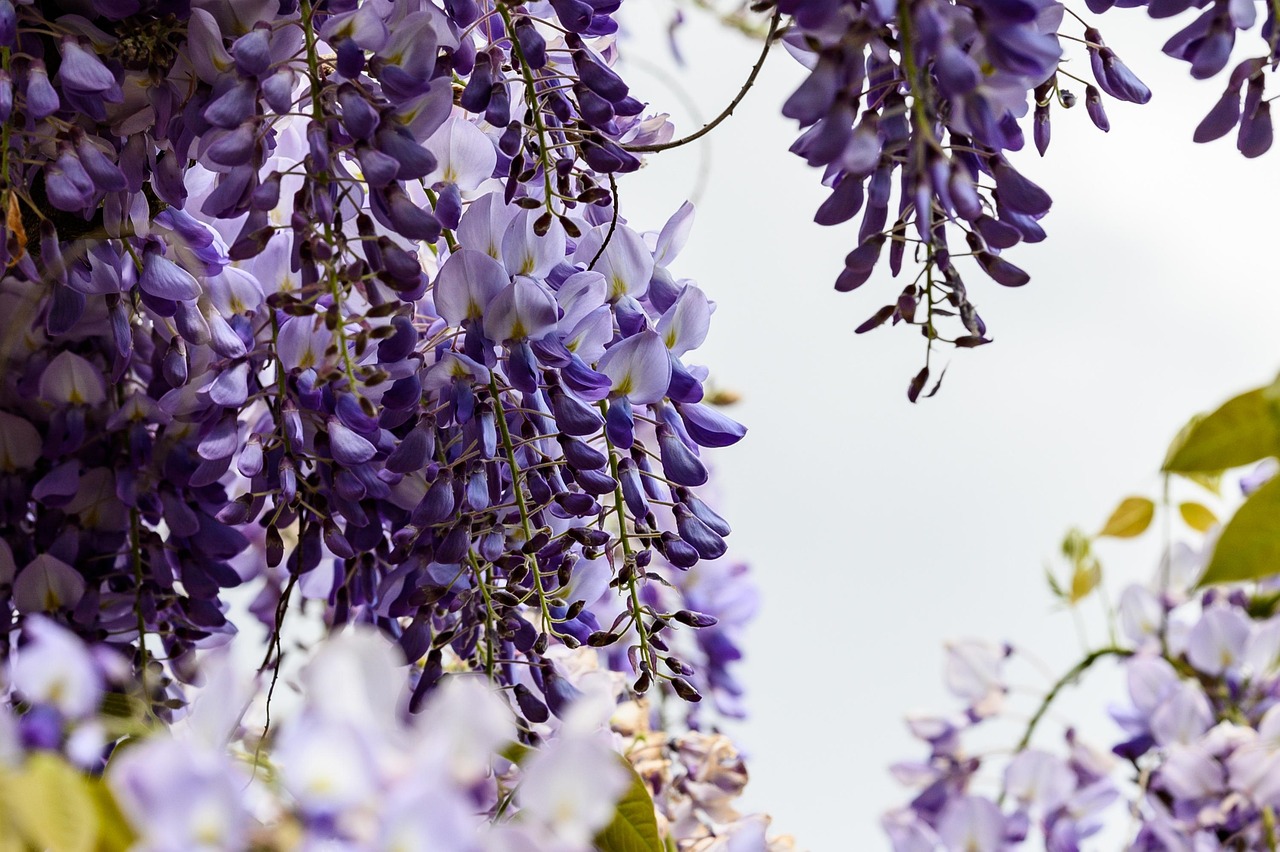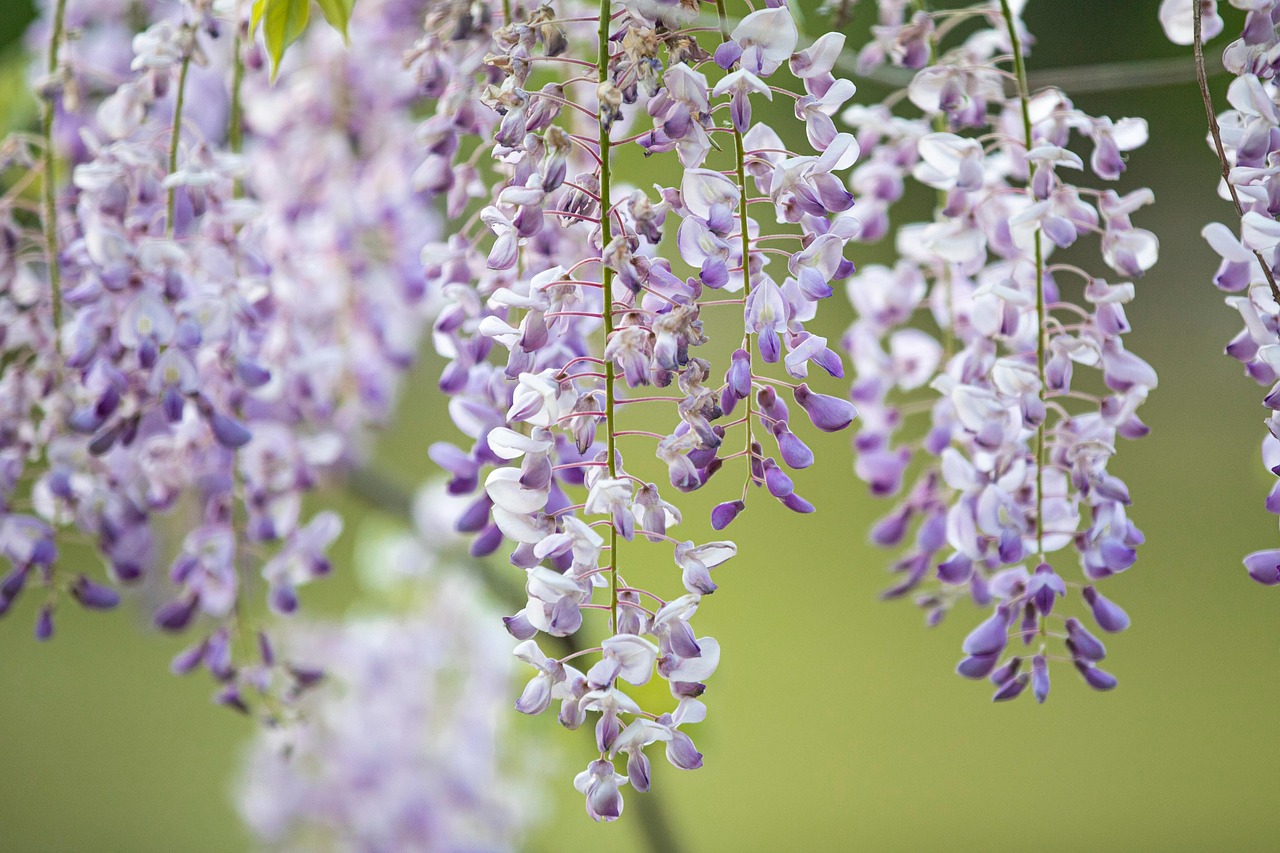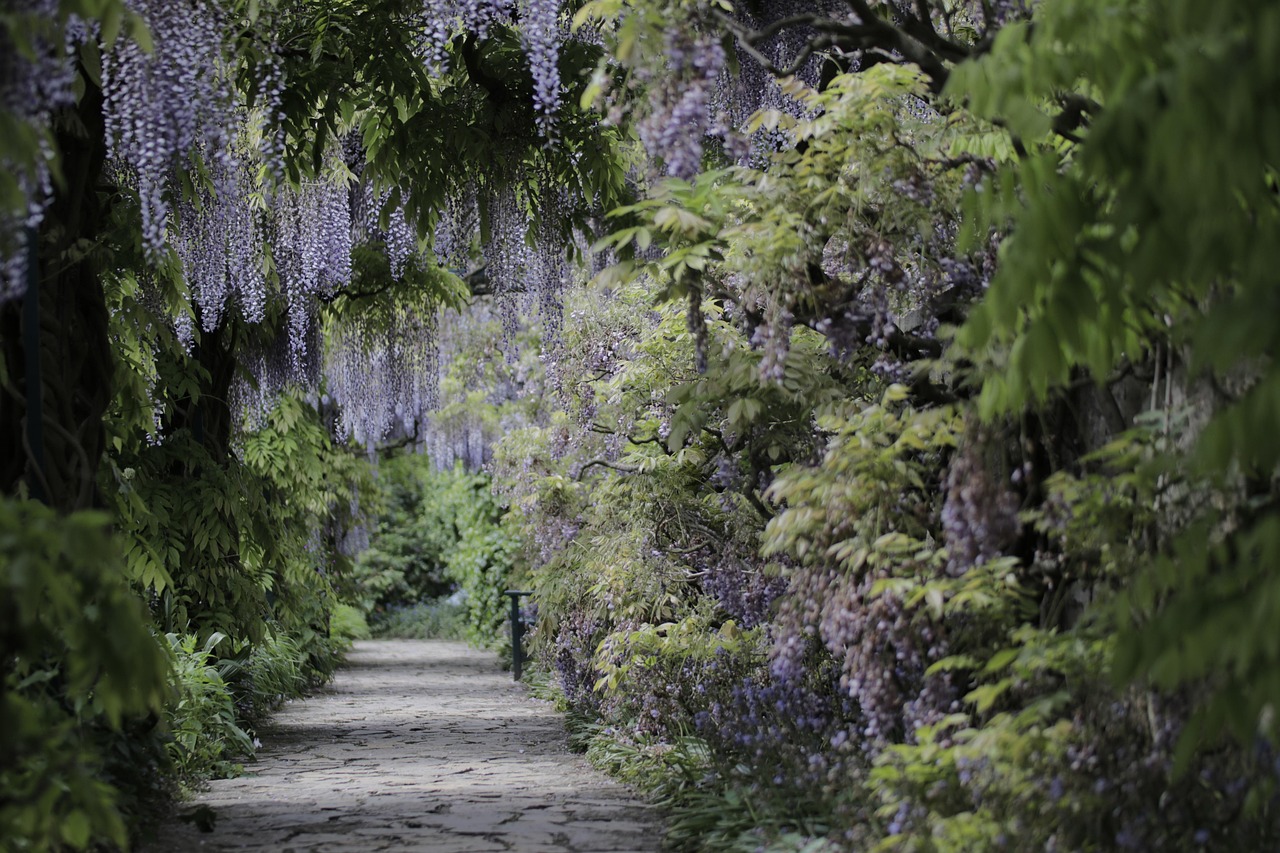Wisteria trees can grow rapidly, reaching heights of 10 to 25 feet in just a few years. Their growth rate is influenced by various factors, including species, soil quality, and climate conditions. With proper care, these trees can thrive and exhibit their stunning vine-like ornamental growth.
Understanding Wisteria Trees
Wisteria is a genus of flowering plants known for their beautiful cascading blooms and vigorous growth. These trees are often used as ornamental plants in gardens and landscapes due to their stunning purple, blue, or white flowers. Wisteria vines can also be trained to grow into tree forms, creating a unique aesthetic in any outdoor space.

There are several species of wisteria, each with its own distinct characteristics. Some of the most popular types include:
- Chinese Wisteria (Wisteria sinensis): This species is known for its long, drooping clusters of flowers and rapid growth rate.
- Japanese Wisteria (Wisteria floribunda): Renowned for its fragrant flowers and longer bloom period, this species is a favorite among gardeners.
- American Wisteria (Wisteria frutescens): This species is less aggressive than its Asian counterparts and is often used in smaller gardens.
The growth rate of wisteria trees is generally fast, making them suitable for gardeners who want quick results. However, their aggressive growth can be a double-edged sword. Without proper management, wisteria can quickly take over an area, outcompeting other plants and climbing over structures.
Factors Influencing Growth Rate
Several factors contribute to the growth rate of wisteria trees. Understanding these elements can help gardeners create optimal conditions for their plants.

Soil Quality
Wisteria thrives in well-drained soil that is rich in organic matter. Soil pH should ideally be between 6.0 and 7.0. Poor soil can stunt growth and lead to health issues. Regularly amending the soil with compost or organic fertilizers can enhance nutrient levels and support vigorous growth.
Climate Conditions
Wisteria is best suited to temperate climates with distinct seasons. They require full sun for at least six hours a day to grow optimally. In regions with harsh winters, wisteria may experience slower growth during the colder months. Conversely, in hot climates, they may need some afternoon shade to protect them from extreme heat.
Watering Practices
While wisteria requires regular watering, especially during dry spells, overwatering can lead to root rot. It is essential to maintain a balance. A good rule of thumb is to water deeply once a week rather than giving them frequent shallow waterings.

Pruning Techniques
Pruning is crucial in managing the growth of wisteria trees. Proper pruning encourages more blooms while controlling their spread. The best time to prune is in late winter or early spring before new growth begins. Regular pruning helps maintain their shape and health and allows for better air circulation.
Growth Rate Overview
The growth rate of wisteria trees can vary depending on several factors. Here is an overview of typical growth rates for different species:
| Species | Average Height (Feet) | Years to Maturity |
|---|---|---|
| Chinese Wisteria | 10-25 | 3-5 |
| Japanese Wisteria | 10-30 | 5-7 |
| American Wisteria | 10-30 | 3-5 |
By understanding these factors and species variations, gardeners can better anticipate the growth potential of their wisteria trees. Whether seeking a majestic tree or a beautiful flowering vine, knowledge about growth rates helps ensure that these stunning plants thrive in any garden setting.
Ideal Growing Conditions for Wisteria Trees
To achieve optimal growth rates, wisteria trees require specific growing conditions. These conditions not only influence how quickly the trees grow but also affect their overall health and blooming potential. Understanding these requirements can help gardeners ensure a flourishing wisteria.

Sunlight Requirements
Wisteria trees thrive in full sunlight. Ideally, they should receive at least six hours of direct sunlight daily. Insufficient sunlight can lead to poor growth and fewer blooms. When planting wisteria, choose a location that is open and receives ample sunlight throughout the day.
Soil Type and Drainage
Wisteria prefers well-drained soil with a loamy texture. Sandy or clay soils can also be suitable if they have adequate drainage. The roots of wisteria are sensitive to standing water, which can lead to root rot. Here are some tips for preparing the soil:
- Test soil pH and aim for a range between 6.0 and 7.0.
- Incorporate organic matter such as compost to improve soil structure.
- If planting in heavy clay, consider amending with sand or perlite to enhance drainage.
Watering Needs
Watering is essential for the establishment and growth of wisteria trees. Newly planted wisteria requires consistent moisture to develop strong roots. Here are some key watering practices:
- Water deeply once a week during dry periods, allowing the soil to dry slightly between waterings.
- Reduce watering frequency once the tree is established, particularly if the region receives regular rainfall.
- Avoid watering in the late afternoon or evening to minimize the risk of fungal diseases.
Fertilizing Wisteria Trees
Proper fertilization can significantly impact the growth rate and flowering of wisteria trees. A balanced approach to fertilization is key.
Types of Fertilizers
Using the right type of fertilizer can enhance growth. Here are some recommended options:
- Slow-release fertilizers: These provide nutrients over time and are ideal for young plants.
- Organic options: Compost or well-rotted manure can enrich the soil naturally without the risk of over-fertilization.
- High-phosphorus fertilizers: These can encourage blooming when applied in early spring before flowering begins.
When to Fertilize
The timing of fertilization plays an important role in plant health. Consider these guidelines:
- Spring: Apply fertilizer in early spring as new growth begins.
- Mid-summer: A second application may be beneficial after flowering has occurred to support continued growth.
Pest and Disease Management
Wisteria trees can be susceptible to various pests and diseases that may affect their growth rate and overall vigor. Awareness and proactive management can help maintain healthy plants.
Common Pests
The following pests are often associated with wisteria trees:
- Wisteria Beetles: These insects feed on the leaves and flowers, causing damage and hindering growth.
- Aphids: These small insects suck sap from the plant, leading to wilting and yellowing leaves.
- Spider Mites: They thrive in dry conditions and can cause leaf discoloration and drop.
Disease Prevention
Diseases can also pose threats to wisteria trees. Some common issues include:
- Root Rot: Caused by overwatering or poor drainage, resulting in wilting and decay.
- Powdery Mildew: This fungal disease appears as a white powdery substance on leaves, typically in humid conditions.
Managing pests and diseases involves regular monitoring, maintaining healthy growing conditions, and seeking organic treatments when necessary. Consistent care helps ensure that wisteria trees remain vigorous and continue to grow at their optimal rates.
As gardeners gain insight into these ideal growing conditions, they can create an environment that supports robust wisteria growth while enjoying the stunning beauty these plants provide.
Training and Supporting Wisteria Trees
Training wisteria trees is crucial for guiding their growth and ensuring they develop into beautiful, ornamental features in your landscape. Proper training not only enhances their aesthetic appeal but also helps manage their aggressive growth habit.
Support Structures
Wisteria trees often require support to grow effectively. They can be trained on various structures, which helps them display their magnificent blooms. Here are some common support options:
- Trellises: These vertical structures are ideal for allowing wisteria to climb and spread, providing a stunning backdrop in gardens.
- Arbors: An arbor can create a beautiful entryway while supporting the vine-like growth of wisteria.
- Fences: Wisteria can be trained to climb along fences, adding privacy and beauty to outdoor spaces.
- Pergolas: These structures offer ample support and create shaded areas adorned with cascading blooms.
Training Techniques
To successfully train wisteria trees, gardeners should employ specific techniques. Here are some effective methods:
- Select a Central Leader: Choose the strongest stem to act as the main trunk. Prune away competing stems to encourage upward growth.
- Guide Growth: Use soft ties or twine to gently secure branches to the support structure, ensuring they grow in the desired direction.
- Regular Pruning: Prune back side shoots regularly to maintain the desired shape and encourage flowering. This also prevents overcrowding of branches.
- Encourage Lateral Growth: Allow some lateral branches to grow for a full appearance, but control their length through pruning.
Seasonal Care for Wisteria Trees
Seasonal care is vital in maintaining the health and vigor of wisteria trees. Different seasons require specific attention to ensure optimal growth.
Spring Care
As wisteria begins to awaken from dormancy, spring is an essential time for care. Key activities include:
- Fertilization: Apply a balanced, slow-release fertilizer to support new growth and flowering.
- Pruning: Conduct any necessary pruning before new leaves emerge to shape the tree and remove dead or damaged wood.
- Watering: Ensure consistent moisture as temperatures rise and new growth begins.
Summer Care
During the summer months, wisteria will be in full bloom. Focus on the following:
- Deadheading: Remove spent flowers to encourage further blooming and prevent unwanted seed production.
- Pest Monitoring: Regularly check for pests such as aphids or beetles, addressing infestations promptly.
- Water Management: Adjust watering based on rainfall and temperature, ensuring not to overwater.
Fall Care
As the growing season winds down, fall care is essential for preparing wisteria trees for winter. Recommended tasks include:
- Final Pruning: Light pruning can help shape the tree and remove any weak or crossing branches.
- Mulching: Apply a layer of mulch around the base to protect roots from temperature fluctuations and retain moisture.
- Watering Before Dormancy: Ensure the tree is well-watered before winter sets in, as this helps it withstand cold conditions.
Winter Care
In winter, wisteria trees enter dormancy. While they require less attention, some care is necessary:
- Protection from Extreme Weather: In regions with harsh winters, consider wrapping young trees in burlap or using frost cloths to shield them from extreme cold.
- No Fertilization: Avoid fertilizing during winter as the tree is dormant and will not take up nutrients.
- Check for Damage: Inspect for any signs of damage from cold or pests during milder winter days.
Caring for wisteria throughout the seasons ensures that these beautiful trees remain healthy and vibrant. By following best practices in training, supporting, and seasonal maintenance, gardeners can enjoy the spectacular display of blooms that wisteria trees have to offer.
Common Misconceptions About Wisteria Growth
Wisteria trees are often admired for their beauty, but there are several misconceptions about their growth and care that may lead to misunderstandings. Addressing these myths can help gardeners better manage their wisteria trees.
Myth 1: Wisteria Grows Well in Any Soil
While wisteria is adaptable, it does not thrive in all soil types. It prefers well-drained, loamy soil rich in organic matter. Heavy clay or overly sandy soils can hinder growth, leading to issues like root rot or nutrient deficiency.
Myth 2: Wisteria Blooms Every Year
Wisteria trees may not bloom annually, especially if they are young or have been recently transplanted. Factors such as insufficient sunlight, poor pruning, and lack of nutrients can affect blooming frequency. Patience and proper care are essential for encouraging consistent flowering.
Myth 3: Wisteria is Low Maintenance
Though wisteria can be resilient once established, they require regular maintenance, particularly in their early years. This includes proper pruning, monitoring for pests, and ensuring adequate watering. Neglecting these aspects may lead to stunted growth or poor blooming.
Landscape Design Ideas with Wisteria
Wisteria trees are versatile plants that can enhance various landscape designs. Here are some creative ideas for incorporating them into your outdoor space:
- Garden Arbors: Create a stunning entrance to your garden by training wisteria to climb over arbors or pergolas. This not only provides shade but also creates an eye-catching focal point.
- Vertical Gardens: Use wisteria in vertical gardens or green walls. Their cascading blooms can soften hard surfaces and add beauty to urban settings.
- Mixed Borders: Pair wisteria with other flowering shrubs and perennials to create dynamic color combinations throughout the growing season.
- Patio Enhancements: Plant wisteria near patios or outdoor seating areas to provide a fragrant and visually appealing backdrop during the blooming season.
Potential Challenges with Wisteria Growth
While wisteria trees are beautiful, they come with challenges that gardeners should be aware of:
Aggressive Growth
Wisteria’s rapid growth can become problematic if left unchecked. Without regular pruning, they may overwhelm nearby plants or structures. It’s crucial to establish a regular pruning schedule to maintain control over their size and shape.
Pest Infestations
Pests such as aphids and beetles can threaten the health of wisteria trees. Regular monitoring and prompt management using organic pest control methods can help prevent infestations from causing significant damage.
Disease Susceptibility
As discussed earlier, wisteria trees can be susceptible to diseases like root rot and powdery mildew. Ensuring proper watering practices and maintaining good air circulation around the plant can mitigate these risks.
Final Thoughts
The growth rate of wisteria trees adds to their allure as ornamental plants. With the right care and environmental conditions, these stunning trees can reach impressive heights and produce breathtaking blooms. Understanding their growth requirements, seasonal care, and potential challenges enables gardeners to cultivate thriving wisteria that enhances any landscape.
By addressing common misconceptions and employing effective training techniques, wisteria can serve as a beautiful addition to gardens and outdoor spaces. Whether used as a climbing vine on trellises or as a standalone tree, wisteria offers both aesthetic appeal and the joy of witnessing its vigorous growth.
In conclusion, wisteria trees require attention and commitment but reward gardeners with spectacular beauty and fragrance. With proper care, they can become a cherished part of any garden, providing years of enjoyment with their enchanting blooms and graceful form.
